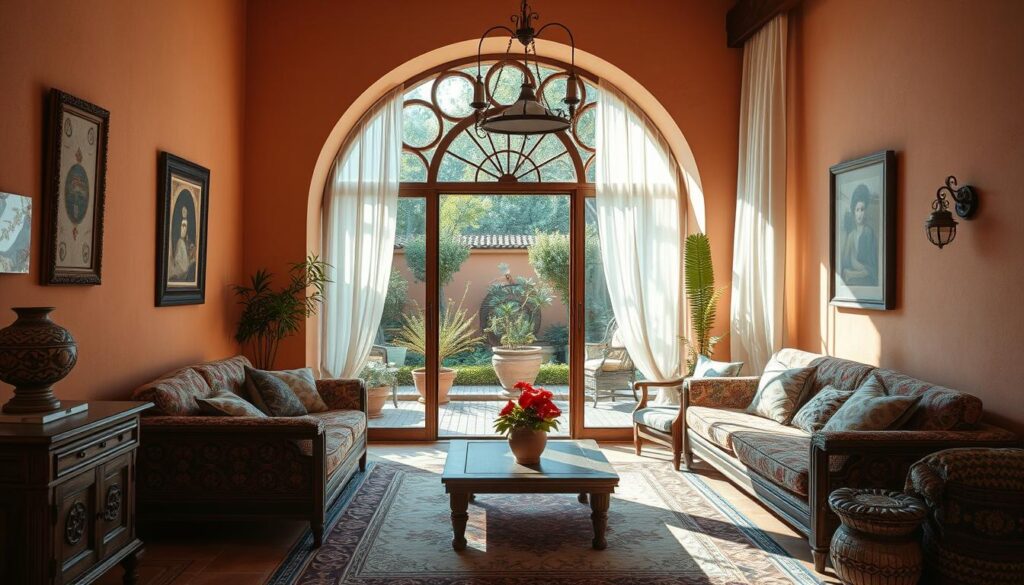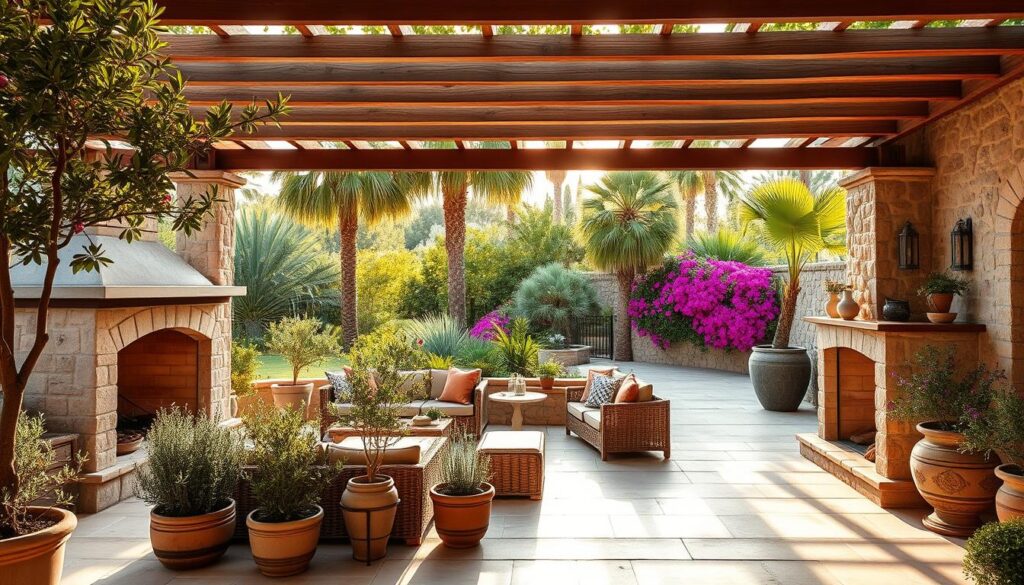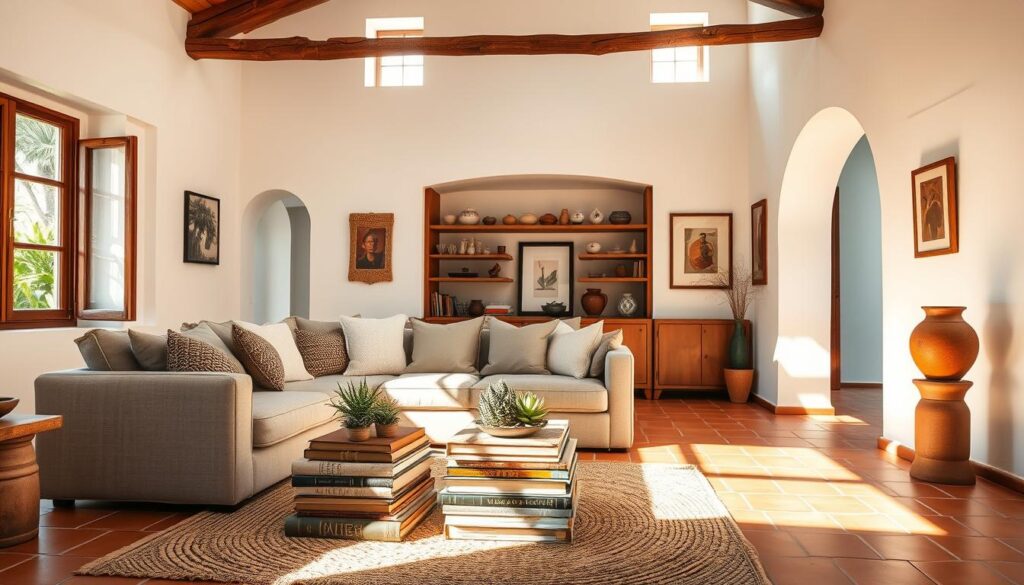The Mediterranean region has won the hearts of design enthusiasts everywhere. It inspires a style that adds warmth and charm to any living space.
Mediterranean style decor is known for its earthy tones, natural textures, and classic looks. It makes any room cozy and welcoming. It’s ideal for those who love a relaxed, coastal feel.
In this guide to Mediterranean home interior design, we’ll look at what makes this style special. We’ll give you the inspiration and tips to add a Mediterranean touch to your home.
Key Takeaways
- Earthy tones and natural textures define Mediterranean style decor
- Mediterranean home interior design creates a cozy and welcoming atmosphere
- Classic architectural elements add a touch of elegance to the space
- A relaxed, coastal vibe is characteristic of Mediterranean-inspired interiors
- Mediterranean style decor is perfect for those seeking a warm and inviting living space
Understanding Mediterranean Design Aesthetics
Mediterranean design brings the warmth and beauty of the Mediterranean region into your home. It’s not just about looks; it’s about creating a lifestyle that feels welcoming and relaxed.
Key Characteristics of Mediterranean Style
Mediterranean design uses natural materials, warm colors, and architectural elements that show the region’s rich culture. Key features include:
- Use of natural stone and wood
- Incorporation of arches and columns
- Emphasis on outdoor living spaces
- Rich, earthy color schemes
These elements create a warm and inviting atmosphere, truly Mediterranean.
Color Palettes Inspired by Nature
The colors in Mediterranean design come from nature. Warm earth tones, cool blues, and soft greens are used to create a natural look.
Popular color schemes include:
- Terracotta and sienna tones
- Soft blues and whites
- Mint greens and sandy beiges
These colors reflect the Mediterranean’s natural beauty and help create a calm atmosphere.
Use of Natural Materials in Decor
Natural materials are key in Mediterranean design. Wood, stone, and clay are used to create a warm and organic feel.
These materials add texture and depth, making spaces more interesting. For example, a wooden beam ceiling or a stone fireplace can be a room’s focal point, adding Mediterranean charm.
Historical Influences on Mediterranean Design
Mediterranean design is a mix of architectural and cultural elements. The Mediterranean region has a rich history and diverse cultures. These have shaped the design aesthetic.
Brief Overview of Mediterranean Architecture
Mediterranean architecture uses natural materials like stone, wood, and clay. These materials were common in the region. The style also considers the climate, with thick walls, large windows, and shaded courtyards to keep cool.
The ancient Greeks and Romans have influenced Mediterranean design. Their use of columns, arches, and domes is seen in many modern homes.
Cultural Impact on Interior Design
The Mediterranean region’s cultural diversity is seen in its interior design. Vibrant colors and intricate patterns are common, influenced by trade and cultural exchange.
- Textiles like rugs and tapestries add warmth and texture to interiors.
- Decorative tiles and ceramics are used to add interest and connect indoors with outdoors.
Evolution Through the Ages
Mediterranean design has changed over the centuries. It has been shaped by historical events and cultural exchanges. From early Christian simplicity to Islamic ornateness, each era has added to the style.
Key elements that have remained constant include:
- The use of natural materials and emphasis on durability.
- A focus on creating a seamless transition between indoors and outdoors.
- The incorporation of decorative elements, such as arches, columns, and intricate tile work.
Understanding the historical influences on Mediterranean design helps us appreciate its beauty and complexity.
Key Elements of Mediterranean Home Interior Design
Mediterranean interior design has key elements that make it unique. We’ll dive into these to see how they bring warmth and elegance to homes.
Open Floor Plans for Spacious Living
Open floor plans are a big part of Mediterranean design. They make rooms feel bigger and let natural light flow freely. This layout encourages family and guests to come together.
It also blends indoor and outdoor spaces well. Large windows and sliding doors connect homes to patios and gardens.
High Ceilings and Arched Doorways
High ceilings add to the airy feel of Mediterranean homes. Arched doorways bring elegance and sophistication. They’re found in doors, windows, and even furniture.
These features honor the Mediterranean’s architectural past. They’ve been used for centuries to create stunning spaces.
Decorative Tile Work and Mosaic Patterns
Decorative tile work and mosaic patterns are key in Mediterranean design. They add color, texture, and interest. From mosaic tables to tile floors, they bring the region’s culture into homes.
Mosaic patterns can be bold or subtle. They often use vibrant colors and geometric shapes. This reflects the Mediterranean’s rich history of craftsmanship.
Color Schemes for Mediterranean Interiors
The color palette is key in Mediterranean interior design. It brings the region’s beauty into your home. The right colors can make you feel like you’re in the Mediterranean, surrounded by warmth and peace.
Warm Earth Tones and Cool Blues
Mediterranean interiors mix warm earth tones with cool blues. Earthy colors like terracotta and golden brown add coziness. They remind us of the region’s rustic beauty.
Cool blues, inspired by the sea, bring calm. Together, these colors create a welcoming space.

How to Choose the Right Palette
Choosing colors for your Mediterranean home involves a few things. First, think about the natural light. Rooms with lots of light can handle deeper colors. Rooms with less light might need lighter shades.
Also, think about your furniture and decor. They should match your color scheme.
Start with a neutral base and add accent colors. This way, you get a stylish and functional look.
Accent Colors to Enhance Your Space
Accent colors are crucial in Mediterranean interiors. Sunny yellows, deep greens, and rich turquoises are popular. They add depth and interest to your space.
- Use sunny yellows for warmth and optimism.
- Deep greens bring a natural, earthy feel.
- Rich turquoises remind us of the Mediterranean Sea.
Furniture Selection for Mediterranean Homes
Furniture is key in Mediterranean interiors, blending comfort with traditional looks. The right pieces can make you feel like you’re in the Mediterranean.
Traditional vs. Modern Mediterranean Furniture
Mediterranean furniture has changed, mixing old skills with new tastes. Traditional pieces often have detailed carvings and warm colors.
Modern Mediterranean furniture is simpler, with clean designs and a focus on being useful. Yet, it keeps the charm of the old style.
Traditional Mediterranean furniture is known for:
- Ornate carvings and decorative details
- Rich, earthy tones and natural materials
- Heavy, sturdy construction
Modern Mediterranean furniture stands out with:
- Clean lines and minimalist design
- Emphasis on functionality and comfort
- Use of natural materials and neutral color palettes
Importance of Comfort and Functionality
Choosing furniture for your Mediterranean home should focus on comfort and use. This style aims to create a welcoming space for family and friends.
Look for furniture that’s both lovely and practical. For instance, a soft sectional sofa in a neutral shade is great for a cozy living room.
| Furniture Piece | Comfort Features | Functional Benefits |
|---|---|---|
| Sofa | Plush cushions, ergonomic design | Seating for multiple people, convertible designs |
| Armchair | Cushioned seats, reclining functions | Additional seating, accent piece |
| Coffee Table | Storage compartments | Surface for drinks and snacks, display space |
Using Vintage Pieces for Authenticity
Adding vintage furniture to your Mediterranean home adds authenticity and charm. Vintage pieces bring history and stories to your space.
“Vintage furniture is not just about aesthetics; it’s about the stories it tells and the memories it holds.”
When searching for vintage items, seek those that match the traditional Mediterranean style. Look for wooden furniture with intricate carvings or ornate metalwork.
Lighting Solutions in Mediterranean Design
The right lighting can turn a space into a Mediterranean oasis. It’s perfect for both relaxing and having fun. We look at how lighting adds warmth and character to Mediterranean interiors.
Natural Light and Large Windows
Mediterranean design loves natural light. Big windows, often arched or rectangular, let sunlight in. This makes the space bright and airy.
We can make this light even better by using sheer curtains or blinds. They let light through without blocking it.
Popular Lighting Fixtures and Styles
Mediterranean interiors also have special lighting fixtures. These add warmth and character. Some favorites include:
- Chandeliers with intricate metalwork or glass details
- Table lamps with ceramic or terracotta bases
- Sconces that look like traditional lanterns
These lights do more than just light up the room. They also decorate and enhance the Mediterranean look.
Importance of Mood Lighting
Mood lighting is key to a Mediterranean home’s inviting feel. Using different light sources, like overhead lights, table lamps, and floor lamps, creates layers of light. This lets us adjust the mood and lighting for any activity.
| Lighting Type | Purpose | Examples |
|---|---|---|
| Ambient Lighting | General illumination | Ceiling fixtures, chandeliers |
| Task Lighting | Focused lighting for tasks | Table lamps, under-cabinet lighting |
| Accent Lighting | Highlighting decorative elements | Sconces, picture lights |
By using these lighting solutions, we can make a Mediterranean-inspired home. It will feel warm, welcoming, and perfectly lit.
Incorporating Textiles and Patterns
In Mediterranean interior design, textiles add warmth and character. They transform a house into a home that feels like the Mediterranean. Fabrics, patterns, and textures are key to this transformation.
Textiles in Mediterranean decor reflect the region’s rich culture. Turkish rugs and Greek embroidery are just examples. Each textile has its own story to tell.
Fabrics That Reflect the Mediterranean Vibe
To capture the Mediterranean style, choose fabrics that reflect its love for natural materials and vibrant colors. Linens, cottons, and silks in earthy tones and sea blues are popular. These fabrics can be used for upholstery, drapes, or throw pillows, adding depth and interest.
Importance of Layering Textures
Layering different textures is crucial in Mediterranean interior design. Combining smooth linens with rough wood or plush rugs with sleek ceramics creates a visually appealing space. This technique adds depth and makes your home welcoming.
Pattern Mixing Techniques
Mixing patterns is an art that can make your Mediterranean-inspired home stunning. The key is to balance patterns for harmony, not chaos. Start with a bold pattern, then add smaller, more subtle ones.
Geometric motifs, floral patterns, and stripes are typical of Mediterranean design. Mix and match them for a unique look. For example, pair a bold rug with floral pillows and striped drapes. Keep a cohesive color palette to tie everything together.
Indoor-Outdoor Living in Mediterranean Homes
In Mediterranean design, the lines between inside and outside are softly blurred. This style loves the mix of nature and our cozy living spaces.
Designing Spacious Outdoor Areas
Creating big outdoor spaces is key in Mediterranean homes. These areas have large patios, green gardens, and comfy seats for relaxing and having fun.

Integrating Nature with Indoor Spaces
Bringing nature inside is done with big windows, sliding doors, and plants. This makes our homes feel open and connected to the outdoors.
Using natural materials like stone, wood, and clay adds warmth and texture inside. It makes our homes feel more welcoming.
Creating Cozy Outdoor Living Spaces
To make outdoor spaces cozy, we choose comfy furniture and soft lighting. We also add decorations that show off the Mediterranean vibe.
Outdoor kitchens and dining spots are also big hits. They let us enjoy eating and hanging out outside.
| Feature | Indoor Implementation | Outdoor Implementation |
|---|---|---|
| Lighting | Warm-toned lamps and sconces | String lights and lanterns |
| Furniture | Plush sofas and armchairs | Wicker and outdoor sectionals |
| Decor | Artwork and indoor plants | Potted plants and outdoor sculptures |
Accessorizing with Mediterranean Flair
Mediterranean home decor is more than just the building. It’s about the details that make it warm and inviting. Accessorizing is key to creating a Mediterranean-inspired home.
Artwork That Complements the Style
Choosing artwork for your Mediterranean home is important. Look for pieces that show the region’s rich culture. Traditional Spanish or Italian art, or Mediterranean landscapes, are great choices.
Opt for artwork with warm, earthy tones that match your home’s color scheme. Bold and vibrant pieces can add a splash of color and draw attention in any room.
Essential Decorative Items and Accents
Decorative items and accents add character to your Mediterranean home. Some must-haves include:
- Wrought iron pieces, such as candle holders or wall decor
- Ceramic vases and pottery in earthy tones
- Textiles, like throw pillows and blankets, with traditional Mediterranean patterns
These items bring authenticity to your space. Mix different textures and patterns to create a beautiful atmosphere.
Plants and Greenery in Interior Design
Adding plants and greenery to your design brings the outdoors in. Mediterranean homes often feature lush greenery, like olive trees or rosemary plants. This adds natural beauty to your space.
Choose plants native to the Mediterranean for best results. They’ll thrive in the local climate and enhance your home’s look. Use planters made from natural materials, like terracotta or wood, to complement your plants.
Final Tips for Achieving Mediterranean Style
To make your home feel warm and elegant, think about the key elements we’ve talked about. By adding Mediterranean design elements, you can make your space beautiful and welcoming.
Practical Steps for Implementation
Begin by adding natural materials like stone and wood to your decor. Choose warm colors and add decorative tile work and mosaic patterns. Vintage pieces can also add authenticity to your space.
Avoiding Common Mistakes
When designing your Mediterranean-style home, avoid too many accessories. Keep a balance between textures and patterns. Make sure your space is both functional and comfortable.
Finding Inspiration and Resources
For more ideas and resources, check out design experts’ advice and home decor websites. Visit showrooms, explore online platforms, and talk to professionals. They can help you reach your Mediterranean home design goals.


